Regional Workface of Public Health Research Facility in Germany
VerifiedAdded on 2023/04/22
|16
|3913
|68
AI Summary
Contribute Materials
Your contribution can guide someone’s learning journey. Share your
documents today.
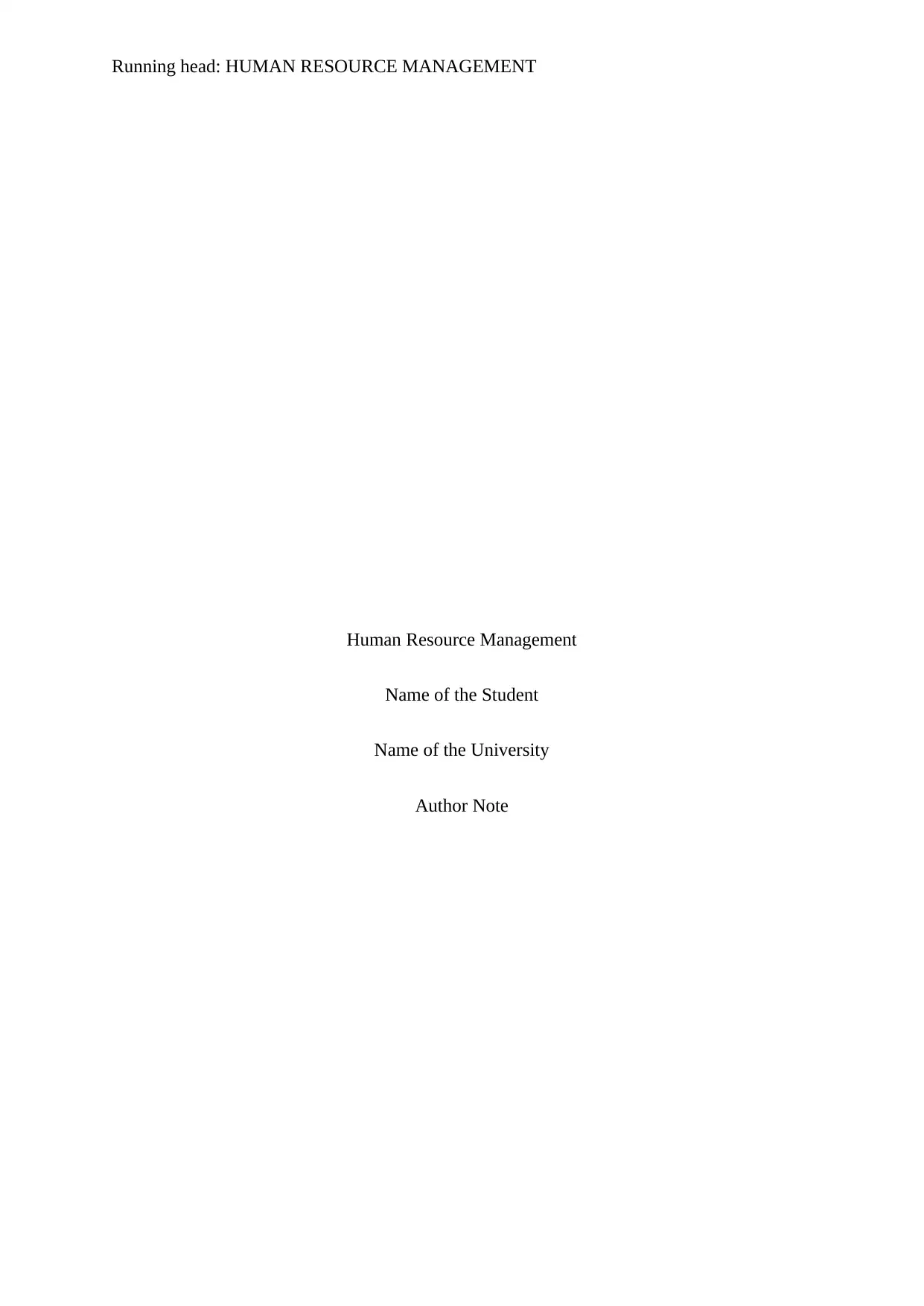
Running head: HUMAN RESOURCE MANAGEMENT
Human Resource Management
Name of the Student
Name of the University
Author Note
Human Resource Management
Name of the Student
Name of the University
Author Note
Secure Best Marks with AI Grader
Need help grading? Try our AI Grader for instant feedback on your assignments.
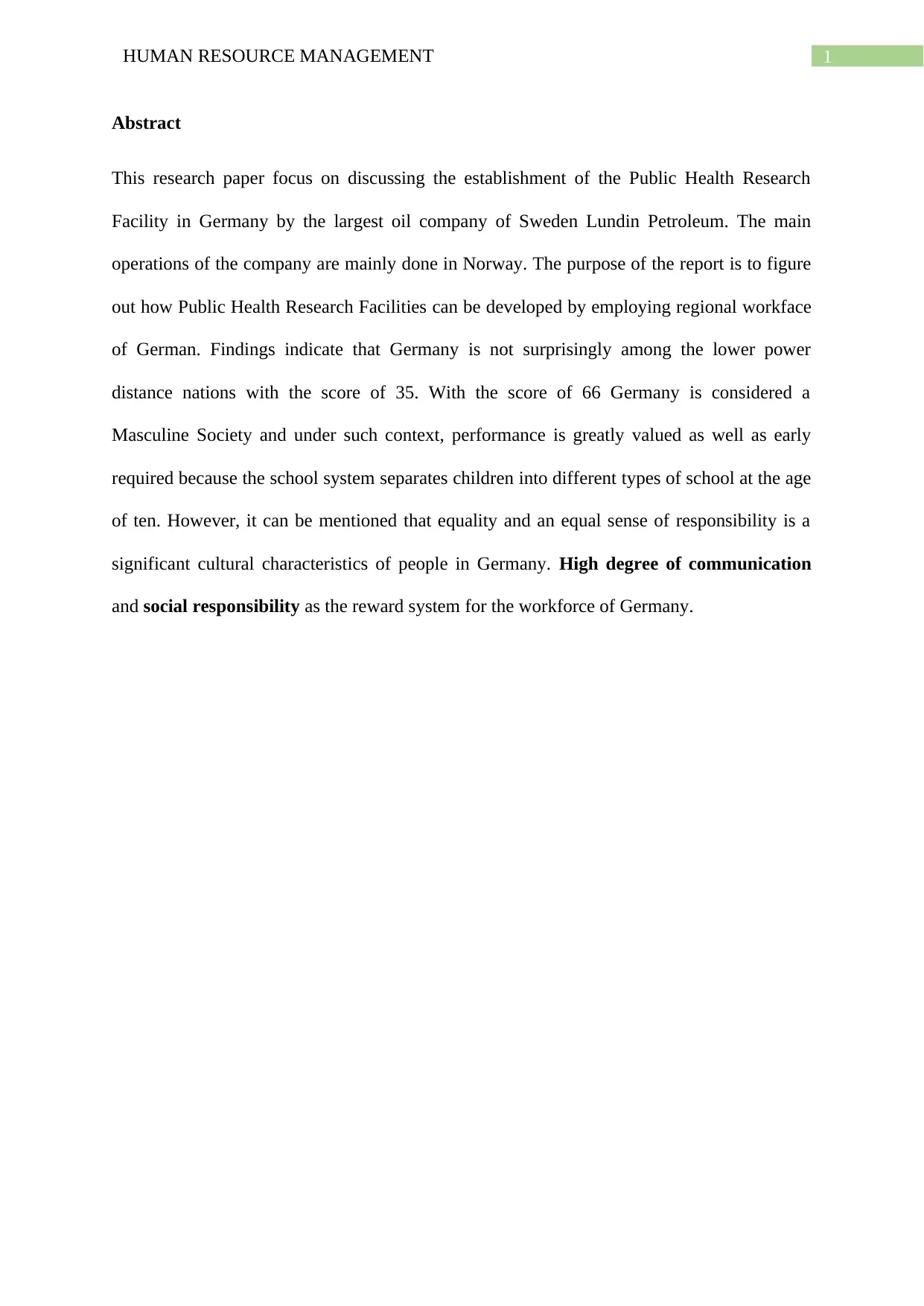
1HUMAN RESOURCE MANAGEMENT
Abstract
This research paper focus on discussing the establishment of the Public Health Research
Facility in Germany by the largest oil company of Sweden Lundin Petroleum. The main
operations of the company are mainly done in Norway. The purpose of the report is to figure
out how Public Health Research Facilities can be developed by employing regional workface
of German. Findings indicate that Germany is not surprisingly among the lower power
distance nations with the score of 35. With the score of 66 Germany is considered a
Masculine Society and under such context, performance is greatly valued as well as early
required because the school system separates children into different types of school at the age
of ten. However, it can be mentioned that equality and an equal sense of responsibility is a
significant cultural characteristics of people in Germany. High degree of communication
and social responsibility as the reward system for the workforce of Germany.
Abstract
This research paper focus on discussing the establishment of the Public Health Research
Facility in Germany by the largest oil company of Sweden Lundin Petroleum. The main
operations of the company are mainly done in Norway. The purpose of the report is to figure
out how Public Health Research Facilities can be developed by employing regional workface
of German. Findings indicate that Germany is not surprisingly among the lower power
distance nations with the score of 35. With the score of 66 Germany is considered a
Masculine Society and under such context, performance is greatly valued as well as early
required because the school system separates children into different types of school at the age
of ten. However, it can be mentioned that equality and an equal sense of responsibility is a
significant cultural characteristics of people in Germany. High degree of communication
and social responsibility as the reward system for the workforce of Germany.
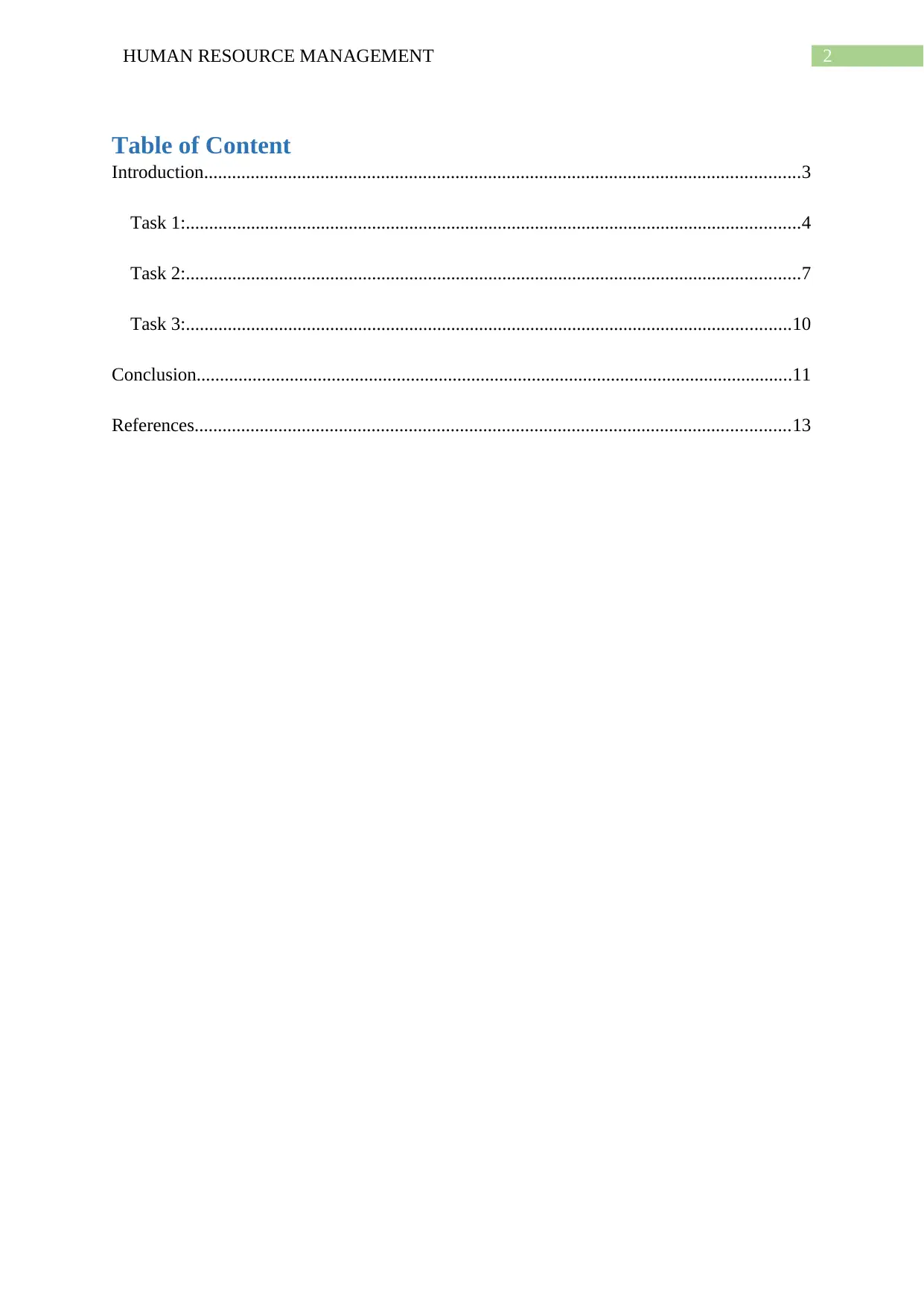
2HUMAN RESOURCE MANAGEMENT
Table of Content
Introduction................................................................................................................................3
Task 1:....................................................................................................................................4
Task 2:....................................................................................................................................7
Task 3:..................................................................................................................................10
Conclusion................................................................................................................................11
References................................................................................................................................13
Table of Content
Introduction................................................................................................................................3
Task 1:....................................................................................................................................4
Task 2:....................................................................................................................................7
Task 3:..................................................................................................................................10
Conclusion................................................................................................................................11
References................................................................................................................................13

3HUMAN RESOURCE MANAGEMENT
Introduction
The following research paper aims to discuss about the establishment of the Public
Health Research Facility in Germany by the largest oil company of Sweden Lundin
Petroleum. The main operations of the company are mainly done in Norway. As the company
is trying to set up the Public Health Research Facility in Germany they will need to address
some relevant issues in this context. The cultural differences are very important when a
company opts out to venture in a new region or country. The company will have to employ
several people for the administrative posts to run their operations smoothly.
In this paper, the cultural differences between Germany and Sweden will have to be
analyzed in order to find the proper ways on how they can gain the profits in the new region.
Through this analysis of the cultures, it would be very important to identify a reward system
that would be beneficial for the German based workforce to be recruited in the company. The
HRM policies will be very important for the organization to utilize the best opportunities.
The organization will have to think upon some ways in which they can attain the
organizational benefits in terms of both money and sustainability.
Apart from that, some alternative solutions have been be given in this paper to support
the German based workforce in the best manner. Some recommendations to improve the
scenario and getting the best results will also be very much needed in this context. These
recommendations will be given on the basis of the outcomes that could be achieved from the
reward systems and the trying to manage the German workforce. The proper ways for
staffing through the human resource management policies will be the primary focus for
completing this paper. The company will need to assess the cultural differences between
Norway and Germany properly as well.
Introduction
The following research paper aims to discuss about the establishment of the Public
Health Research Facility in Germany by the largest oil company of Sweden Lundin
Petroleum. The main operations of the company are mainly done in Norway. As the company
is trying to set up the Public Health Research Facility in Germany they will need to address
some relevant issues in this context. The cultural differences are very important when a
company opts out to venture in a new region or country. The company will have to employ
several people for the administrative posts to run their operations smoothly.
In this paper, the cultural differences between Germany and Sweden will have to be
analyzed in order to find the proper ways on how they can gain the profits in the new region.
Through this analysis of the cultures, it would be very important to identify a reward system
that would be beneficial for the German based workforce to be recruited in the company. The
HRM policies will be very important for the organization to utilize the best opportunities.
The organization will have to think upon some ways in which they can attain the
organizational benefits in terms of both money and sustainability.
Apart from that, some alternative solutions have been be given in this paper to support
the German based workforce in the best manner. Some recommendations to improve the
scenario and getting the best results will also be very much needed in this context. These
recommendations will be given on the basis of the outcomes that could be achieved from the
reward systems and the trying to manage the German workforce. The proper ways for
staffing through the human resource management policies will be the primary focus for
completing this paper. The company will need to assess the cultural differences between
Norway and Germany properly as well.
Secure Best Marks with AI Grader
Need help grading? Try our AI Grader for instant feedback on your assignments.
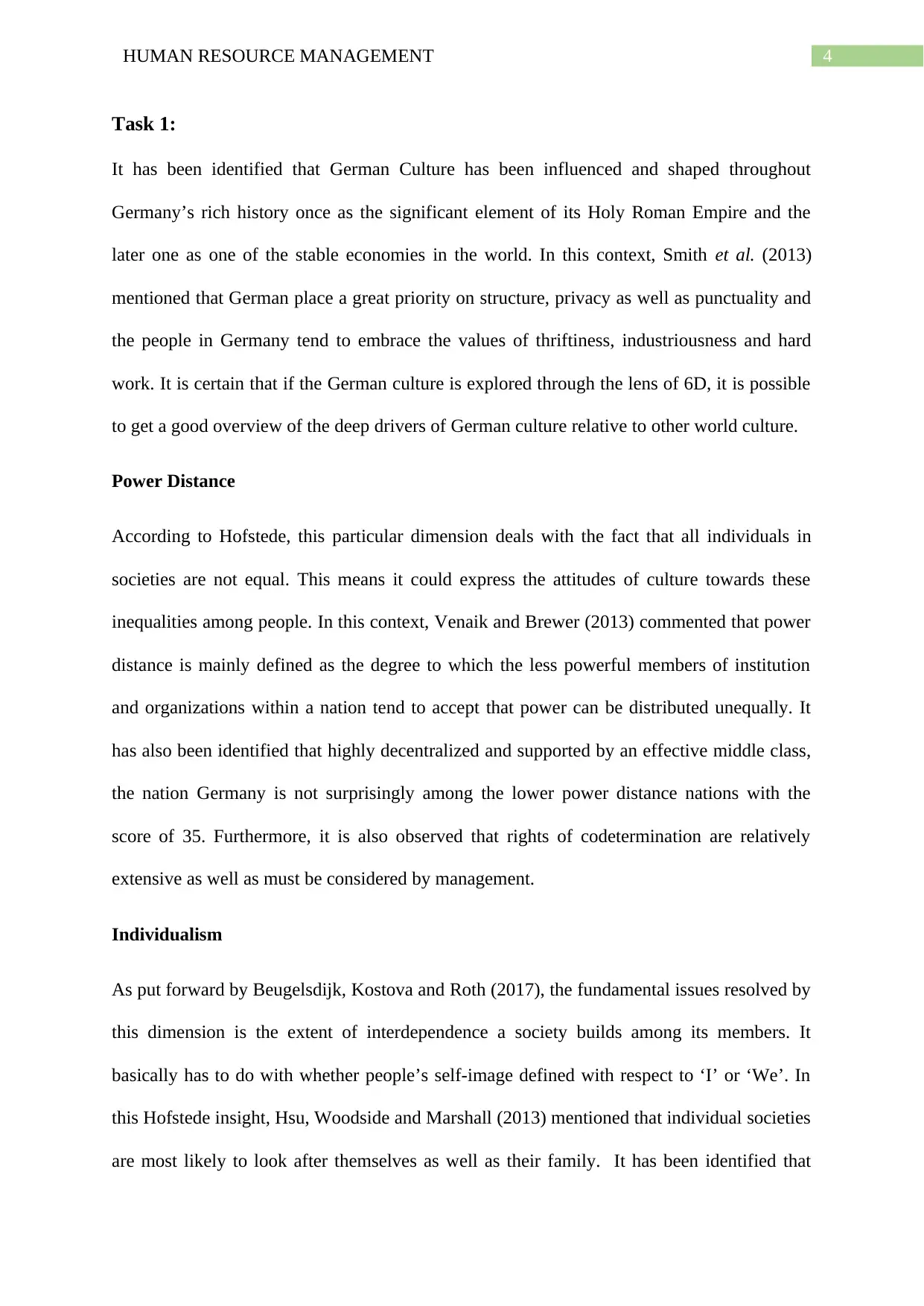
4HUMAN RESOURCE MANAGEMENT
Task 1:
It has been identified that German Culture has been influenced and shaped throughout
Germany’s rich history once as the significant element of its Holy Roman Empire and the
later one as one of the stable economies in the world. In this context, Smith et al. (2013)
mentioned that German place a great priority on structure, privacy as well as punctuality and
the people in Germany tend to embrace the values of thriftiness, industriousness and hard
work. It is certain that if the German culture is explored through the lens of 6D, it is possible
to get a good overview of the deep drivers of German culture relative to other world culture.
Power Distance
According to Hofstede, this particular dimension deals with the fact that all individuals in
societies are not equal. This means it could express the attitudes of culture towards these
inequalities among people. In this context, Venaik and Brewer (2013) commented that power
distance is mainly defined as the degree to which the less powerful members of institution
and organizations within a nation tend to accept that power can be distributed unequally. It
has also been identified that highly decentralized and supported by an effective middle class,
the nation Germany is not surprisingly among the lower power distance nations with the
score of 35. Furthermore, it is also observed that rights of codetermination are relatively
extensive as well as must be considered by management.
Individualism
As put forward by Beugelsdijk, Kostova and Roth (2017), the fundamental issues resolved by
this dimension is the extent of interdependence a society builds among its members. It
basically has to do with whether people’s self-image defined with respect to ‘I’ or ‘We’. In
this Hofstede insight, Hsu, Woodside and Marshall (2013) mentioned that individual societies
are most likely to look after themselves as well as their family. It has been identified that
Task 1:
It has been identified that German Culture has been influenced and shaped throughout
Germany’s rich history once as the significant element of its Holy Roman Empire and the
later one as one of the stable economies in the world. In this context, Smith et al. (2013)
mentioned that German place a great priority on structure, privacy as well as punctuality and
the people in Germany tend to embrace the values of thriftiness, industriousness and hard
work. It is certain that if the German culture is explored through the lens of 6D, it is possible
to get a good overview of the deep drivers of German culture relative to other world culture.
Power Distance
According to Hofstede, this particular dimension deals with the fact that all individuals in
societies are not equal. This means it could express the attitudes of culture towards these
inequalities among people. In this context, Venaik and Brewer (2013) commented that power
distance is mainly defined as the degree to which the less powerful members of institution
and organizations within a nation tend to accept that power can be distributed unequally. It
has also been identified that highly decentralized and supported by an effective middle class,
the nation Germany is not surprisingly among the lower power distance nations with the
score of 35. Furthermore, it is also observed that rights of codetermination are relatively
extensive as well as must be considered by management.
Individualism
As put forward by Beugelsdijk, Kostova and Roth (2017), the fundamental issues resolved by
this dimension is the extent of interdependence a society builds among its members. It
basically has to do with whether people’s self-image defined with respect to ‘I’ or ‘We’. In
this Hofstede insight, Hsu, Woodside and Marshall (2013) mentioned that individual societies
are most likely to look after themselves as well as their family. It has been identified that

5HUMAN RESOURCE MANAGEMENT
German society is genuinely individualist one as there are many small families with the
fundamental focus on parent-children relationship instead of aunts and uncles are most
general. Nistor et al. (2014) mentioned the fact that there is a strong belief in the idea of self-
actualization in which loyalty is based on personal preferences for people as well as sense of
duty and responsibility. This can be defined by the contract between the employer as well as
the employee.
It can be mentioned that communication is known as the most direct in the world following
the idea to be honest even it is not effective and but this provides a fair chance to learn from
the mistakes.
Masculinity
As put forward by Engelen et al. (2014) in the context of Germany a high score on this
dimension implies that the society could be driven by the competition, achievement and
success. It is certain that a value system which initiates in school tend to continue throughout
the organizational life. A low score on the dimension refers to the dominant value in the
society are caring for others as well as quality of life. It has been identified that with the score
of 66 Germany is considered a Masculine Society and under such context, performance is
greatly valued as well as early required because the school system separates children into
different types of school at the age of ten. People instead of living in order to work, they draw
a lot of self-esteem from their task. Manager are often expected to be assertive and decisive.
Uncertainty Avoidance
It has been identified that dimension of Uncertainty Avoidance must have to do with
the way that a society manages with the fact that the future cannot be predicted and the
questions may arise whether individuals should seek to control the future or they just should
let it occur. It has been identified that Germany is among uncertainty avoidance nation with
German society is genuinely individualist one as there are many small families with the
fundamental focus on parent-children relationship instead of aunts and uncles are most
general. Nistor et al. (2014) mentioned the fact that there is a strong belief in the idea of self-
actualization in which loyalty is based on personal preferences for people as well as sense of
duty and responsibility. This can be defined by the contract between the employer as well as
the employee.
It can be mentioned that communication is known as the most direct in the world following
the idea to be honest even it is not effective and but this provides a fair chance to learn from
the mistakes.
Masculinity
As put forward by Engelen et al. (2014) in the context of Germany a high score on this
dimension implies that the society could be driven by the competition, achievement and
success. It is certain that a value system which initiates in school tend to continue throughout
the organizational life. A low score on the dimension refers to the dominant value in the
society are caring for others as well as quality of life. It has been identified that with the score
of 66 Germany is considered a Masculine Society and under such context, performance is
greatly valued as well as early required because the school system separates children into
different types of school at the age of ten. People instead of living in order to work, they draw
a lot of self-esteem from their task. Manager are often expected to be assertive and decisive.
Uncertainty Avoidance
It has been identified that dimension of Uncertainty Avoidance must have to do with
the way that a society manages with the fact that the future cannot be predicted and the
questions may arise whether individuals should seek to control the future or they just should
let it occur. It has been identified that Germany is among uncertainty avoidance nation with

6HUMAN RESOURCE MANAGEMENT
the score of 65 and it is worth telling that score is on the high end; thus, it can be mentioned
that there is a slight and significant preference for deductive instead of inductive approach.
However, Podrug, Filipović and Stančić (2014) mentioned that be it in thinking, presenting or
planning, the systematic overview must be given to proceed. Furthermore when it is
considered with the low power distance in which certainty for individual decisions are not
covered by larger responsibility of the boss, people in German prefer to compensate for their
higher uncertainty by effectively depending on the expertise.
Indulgence
One significant barrier that deals with the humanity now and even in the past is the extent to
which small children are led to towards the action of socializing. According to the authors,
humanity doomed to failure. Such dimension is defined as the degreed of which people seek
to control their desires as well as impulses. Here, relatively weak control is known as
indulgence, while the strong control is known as “Restraint” but in the case of Germany, it is
worth telling that low score of 40 in this dimension tend to imply that German culture is
restrained in nature. On the other side, restrained societies do not put much time on leisure
time and gratification of other needs and desires.
So, on the basis of the analysis above, it can be mentioned that if the Swedish organization
has to deal with the German workforce, management of the organisation mist have to
consider the fact that equality is one of significant and dominant trait among the people in
Germany because too much control over the people is disliked and maintenance of leadership
style among such people could be challenging. It has also been identified that Germany is
more of masculine society and people have the tendency to consider the own values and self-
actualization. Thus, Swedish organization when working with the German workforce must
have to deal with the self-actualization needs.
the score of 65 and it is worth telling that score is on the high end; thus, it can be mentioned
that there is a slight and significant preference for deductive instead of inductive approach.
However, Podrug, Filipović and Stančić (2014) mentioned that be it in thinking, presenting or
planning, the systematic overview must be given to proceed. Furthermore when it is
considered with the low power distance in which certainty for individual decisions are not
covered by larger responsibility of the boss, people in German prefer to compensate for their
higher uncertainty by effectively depending on the expertise.
Indulgence
One significant barrier that deals with the humanity now and even in the past is the extent to
which small children are led to towards the action of socializing. According to the authors,
humanity doomed to failure. Such dimension is defined as the degreed of which people seek
to control their desires as well as impulses. Here, relatively weak control is known as
indulgence, while the strong control is known as “Restraint” but in the case of Germany, it is
worth telling that low score of 40 in this dimension tend to imply that German culture is
restrained in nature. On the other side, restrained societies do not put much time on leisure
time and gratification of other needs and desires.
So, on the basis of the analysis above, it can be mentioned that if the Swedish organization
has to deal with the German workforce, management of the organisation mist have to
consider the fact that equality is one of significant and dominant trait among the people in
Germany because too much control over the people is disliked and maintenance of leadership
style among such people could be challenging. It has also been identified that Germany is
more of masculine society and people have the tendency to consider the own values and self-
actualization. Thus, Swedish organization when working with the German workforce must
have to deal with the self-actualization needs.
Paraphrase This Document
Need a fresh take? Get an instant paraphrase of this document with our AI Paraphraser
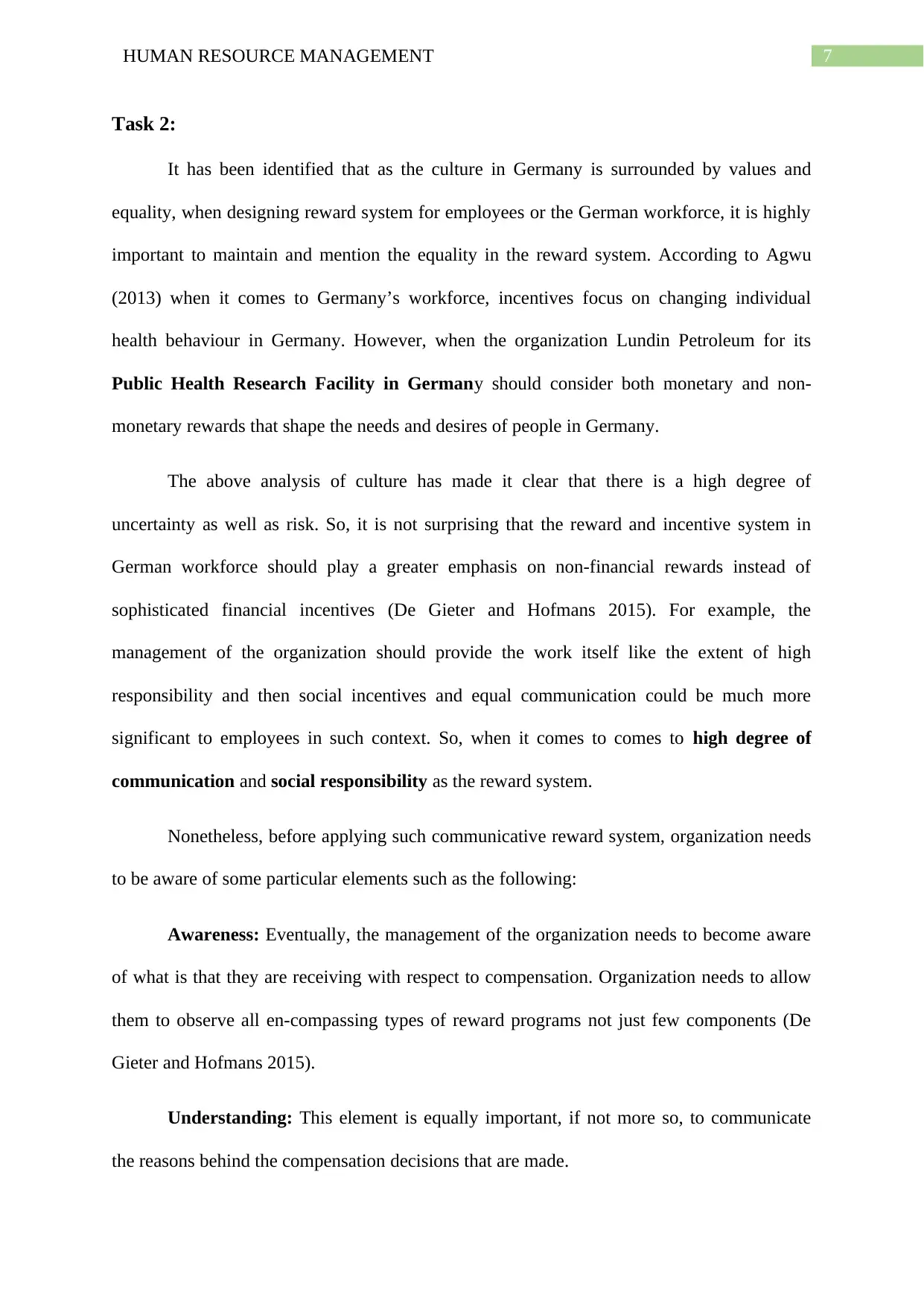
7HUMAN RESOURCE MANAGEMENT
Task 2:
It has been identified that as the culture in Germany is surrounded by values and
equality, when designing reward system for employees or the German workforce, it is highly
important to maintain and mention the equality in the reward system. According to Agwu
(2013) when it comes to Germany’s workforce, incentives focus on changing individual
health behaviour in Germany. However, when the organization Lundin Petroleum for its
Public Health Research Facility in Germany should consider both monetary and non-
monetary rewards that shape the needs and desires of people in Germany.
The above analysis of culture has made it clear that there is a high degree of
uncertainty as well as risk. So, it is not surprising that the reward and incentive system in
German workforce should play a greater emphasis on non-financial rewards instead of
sophisticated financial incentives (De Gieter and Hofmans 2015). For example, the
management of the organization should provide the work itself like the extent of high
responsibility and then social incentives and equal communication could be much more
significant to employees in such context. So, when it comes to comes to high degree of
communication and social responsibility as the reward system.
Nonetheless, before applying such communicative reward system, organization needs
to be aware of some particular elements such as the following:
Awareness: Eventually, the management of the organization needs to become aware
of what is that they are receiving with respect to compensation. Organization needs to allow
them to observe all en-compassing types of reward programs not just few components (De
Gieter and Hofmans 2015).
Understanding: This element is equally important, if not more so, to communicate
the reasons behind the compensation decisions that are made.
Task 2:
It has been identified that as the culture in Germany is surrounded by values and
equality, when designing reward system for employees or the German workforce, it is highly
important to maintain and mention the equality in the reward system. According to Agwu
(2013) when it comes to Germany’s workforce, incentives focus on changing individual
health behaviour in Germany. However, when the organization Lundin Petroleum for its
Public Health Research Facility in Germany should consider both monetary and non-
monetary rewards that shape the needs and desires of people in Germany.
The above analysis of culture has made it clear that there is a high degree of
uncertainty as well as risk. So, it is not surprising that the reward and incentive system in
German workforce should play a greater emphasis on non-financial rewards instead of
sophisticated financial incentives (De Gieter and Hofmans 2015). For example, the
management of the organization should provide the work itself like the extent of high
responsibility and then social incentives and equal communication could be much more
significant to employees in such context. So, when it comes to comes to high degree of
communication and social responsibility as the reward system.
Nonetheless, before applying such communicative reward system, organization needs
to be aware of some particular elements such as the following:
Awareness: Eventually, the management of the organization needs to become aware
of what is that they are receiving with respect to compensation. Organization needs to allow
them to observe all en-compassing types of reward programs not just few components (De
Gieter and Hofmans 2015).
Understanding: This element is equally important, if not more so, to communicate
the reasons behind the compensation decisions that are made.
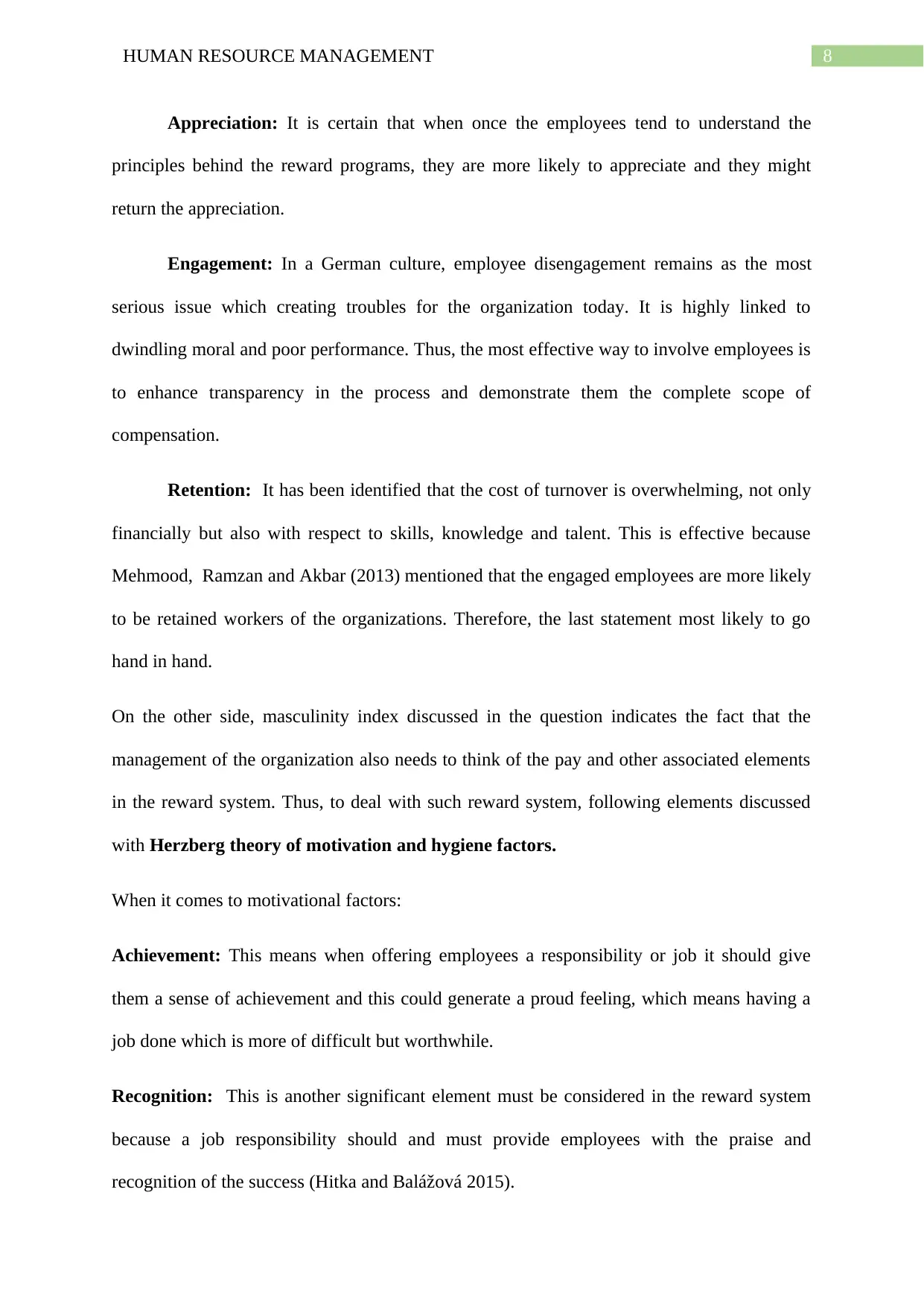
8HUMAN RESOURCE MANAGEMENT
Appreciation: It is certain that when once the employees tend to understand the
principles behind the reward programs, they are more likely to appreciate and they might
return the appreciation.
Engagement: In a German culture, employee disengagement remains as the most
serious issue which creating troubles for the organization today. It is highly linked to
dwindling moral and poor performance. Thus, the most effective way to involve employees is
to enhance transparency in the process and demonstrate them the complete scope of
compensation.
Retention: It has been identified that the cost of turnover is overwhelming, not only
financially but also with respect to skills, knowledge and talent. This is effective because
Mehmood, Ramzan and Akbar (2013) mentioned that the engaged employees are more likely
to be retained workers of the organizations. Therefore, the last statement most likely to go
hand in hand.
On the other side, masculinity index discussed in the question indicates the fact that the
management of the organization also needs to think of the pay and other associated elements
in the reward system. Thus, to deal with such reward system, following elements discussed
with Herzberg theory of motivation and hygiene factors.
When it comes to motivational factors:
Achievement: This means when offering employees a responsibility or job it should give
them a sense of achievement and this could generate a proud feeling, which means having a
job done which is more of difficult but worthwhile.
Recognition: This is another significant element must be considered in the reward system
because a job responsibility should and must provide employees with the praise and
recognition of the success (Hitka and Balážová 2015).
Appreciation: It is certain that when once the employees tend to understand the
principles behind the reward programs, they are more likely to appreciate and they might
return the appreciation.
Engagement: In a German culture, employee disengagement remains as the most
serious issue which creating troubles for the organization today. It is highly linked to
dwindling moral and poor performance. Thus, the most effective way to involve employees is
to enhance transparency in the process and demonstrate them the complete scope of
compensation.
Retention: It has been identified that the cost of turnover is overwhelming, not only
financially but also with respect to skills, knowledge and talent. This is effective because
Mehmood, Ramzan and Akbar (2013) mentioned that the engaged employees are more likely
to be retained workers of the organizations. Therefore, the last statement most likely to go
hand in hand.
On the other side, masculinity index discussed in the question indicates the fact that the
management of the organization also needs to think of the pay and other associated elements
in the reward system. Thus, to deal with such reward system, following elements discussed
with Herzberg theory of motivation and hygiene factors.
When it comes to motivational factors:
Achievement: This means when offering employees a responsibility or job it should give
them a sense of achievement and this could generate a proud feeling, which means having a
job done which is more of difficult but worthwhile.
Recognition: This is another significant element must be considered in the reward system
because a job responsibility should and must provide employees with the praise and
recognition of the success (Hitka and Balážová 2015).

9HUMAN RESOURCE MANAGEMENT
Work itself: Job itself has to be interesting which means when designing work or sharing
responsibility in Public Health Research Facility, the shared work should be more of
challenge of keeping the employees motivated as sense of equality and responsibility is a
concern in the discussed culture.
Advancement: Promotion opportunities must exist for the employees in the reward system.
Growth: Job must give employees the opportunity to learn new skills and this must happen
in the job or during the formal training.
When designing rewards, hygiene factors should also be prioritized in the scheme. Following
are some of the element required to be considered.
Company policies: The organization Lundin Petroleum should be aware of the fact that
company policies are fair and clear to each and every one and they should be equivalent to
those of rivals.
Supervision- When supervising employees, organization needs to learn about the fact that
supervisor of employees working under the programs are fair and appropriate. The employees
should also give that autonomy which is reasonable.
Work Conditions: When providing employees with certain work or responsibility, it is
certain that working environment must be safe fit and hygienic.
Salary: Pay structure of the organization must be fair as well as reasonable.
Status: As discussed about the equality in the above discussion of Hofstede culture, the
organization must have to keep up the status of all workers within the company and it is true
that performing meaningful work can create a sense of status.
Work itself: Job itself has to be interesting which means when designing work or sharing
responsibility in Public Health Research Facility, the shared work should be more of
challenge of keeping the employees motivated as sense of equality and responsibility is a
concern in the discussed culture.
Advancement: Promotion opportunities must exist for the employees in the reward system.
Growth: Job must give employees the opportunity to learn new skills and this must happen
in the job or during the formal training.
When designing rewards, hygiene factors should also be prioritized in the scheme. Following
are some of the element required to be considered.
Company policies: The organization Lundin Petroleum should be aware of the fact that
company policies are fair and clear to each and every one and they should be equivalent to
those of rivals.
Supervision- When supervising employees, organization needs to learn about the fact that
supervisor of employees working under the programs are fair and appropriate. The employees
should also give that autonomy which is reasonable.
Work Conditions: When providing employees with certain work or responsibility, it is
certain that working environment must be safe fit and hygienic.
Salary: Pay structure of the organization must be fair as well as reasonable.
Status: As discussed about the equality in the above discussion of Hofstede culture, the
organization must have to keep up the status of all workers within the company and it is true
that performing meaningful work can create a sense of status.
Secure Best Marks with AI Grader
Need help grading? Try our AI Grader for instant feedback on your assignments.
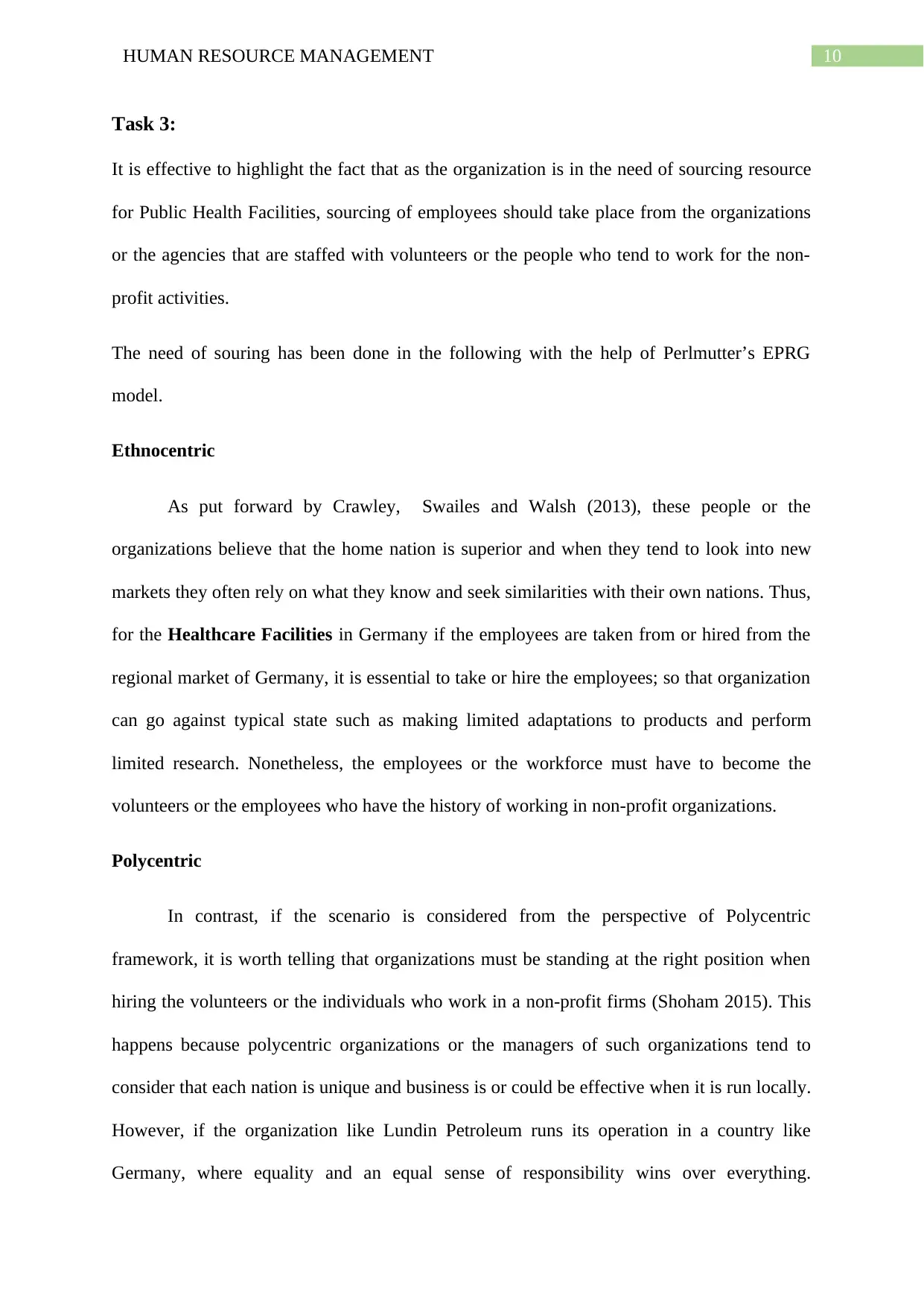
10HUMAN RESOURCE MANAGEMENT
Task 3:
It is effective to highlight the fact that as the organization is in the need of sourcing resource
for Public Health Facilities, sourcing of employees should take place from the organizations
or the agencies that are staffed with volunteers or the people who tend to work for the non-
profit activities.
The need of souring has been done in the following with the help of Perlmutter’s EPRG
model.
Ethnocentric
As put forward by Crawley, Swailes and Walsh (2013), these people or the
organizations believe that the home nation is superior and when they tend to look into new
markets they often rely on what they know and seek similarities with their own nations. Thus,
for the Healthcare Facilities in Germany if the employees are taken from or hired from the
regional market of Germany, it is essential to take or hire the employees; so that organization
can go against typical state such as making limited adaptations to products and perform
limited research. Nonetheless, the employees or the workforce must have to become the
volunteers or the employees who have the history of working in non-profit organizations.
Polycentric
In contrast, if the scenario is considered from the perspective of Polycentric
framework, it is worth telling that organizations must be standing at the right position when
hiring the volunteers or the individuals who work in a non-profit firms (Shoham 2015). This
happens because polycentric organizations or the managers of such organizations tend to
consider that each nation is unique and business is or could be effective when it is run locally.
However, if the organization like Lundin Petroleum runs its operation in a country like
Germany, where equality and an equal sense of responsibility wins over everything.
Task 3:
It is effective to highlight the fact that as the organization is in the need of sourcing resource
for Public Health Facilities, sourcing of employees should take place from the organizations
or the agencies that are staffed with volunteers or the people who tend to work for the non-
profit activities.
The need of souring has been done in the following with the help of Perlmutter’s EPRG
model.
Ethnocentric
As put forward by Crawley, Swailes and Walsh (2013), these people or the
organizations believe that the home nation is superior and when they tend to look into new
markets they often rely on what they know and seek similarities with their own nations. Thus,
for the Healthcare Facilities in Germany if the employees are taken from or hired from the
regional market of Germany, it is essential to take or hire the employees; so that organization
can go against typical state such as making limited adaptations to products and perform
limited research. Nonetheless, the employees or the workforce must have to become the
volunteers or the employees who have the history of working in non-profit organizations.
Polycentric
In contrast, if the scenario is considered from the perspective of Polycentric
framework, it is worth telling that organizations must be standing at the right position when
hiring the volunteers or the individuals who work in a non-profit firms (Shoham 2015). This
happens because polycentric organizations or the managers of such organizations tend to
consider that each nation is unique and business is or could be effective when it is run locally.
However, if the organization like Lundin Petroleum runs its operation in a country like
Germany, where equality and an equal sense of responsibility wins over everything.

11HUMAN RESOURCE MANAGEMENT
Nonetheless, if the sourcing of Public Health Facilities are done from the regional
environment of German, it is worth stating that it could be effective for the organization
because, head office of the organization has a very limited control over the activities in each
market when it is operated under a polycentric framework. As people in Germany tend to
share equal responsibility, sense of control, prioritize own decisions, people will not face
much difficulties working under an oversea as the attempt from the head office to make use
of good ideas and best practices from other market is limited. This means that eventually
control will be on the regional managers or supervisors who are hired from Germany’s
market.
Regiocentric- As put forward by Lakshman (2013), a regiocentric organization tends
to consider similarities and differences in world and designs strategies around this. It is
certain that there could be some differences between the nations in a region. For example,
there is a large gap of culture between Germany and Sweden both are located in the European
Continent but both the nations are culturally different. So, there could be challenges about
how organizations are treating the employees belonging to German (Keller and Lewis 2016).
There is a state of contradictions both in regional and corporate culture. Thus, the
organization bellowing to Sweden is not supposed to apply its own culture in a German
workforce. Thus, to avoid this contradictions, the organization needs to think of or apply the
concept of geocentric which is the mixture of polycentric and ethnocentric. This is because
this framework enables organizations to think in a global way but act in a local way. So,
Culture and traits of people living in German can be highly prioritized.
Conclusion
In conclusion it can be mentioned that Lundin Petroleum of Sweden should conduct or
perform a broad market analysis through which it can be learned that how people in Germany
Nonetheless, if the sourcing of Public Health Facilities are done from the regional
environment of German, it is worth stating that it could be effective for the organization
because, head office of the organization has a very limited control over the activities in each
market when it is operated under a polycentric framework. As people in Germany tend to
share equal responsibility, sense of control, prioritize own decisions, people will not face
much difficulties working under an oversea as the attempt from the head office to make use
of good ideas and best practices from other market is limited. This means that eventually
control will be on the regional managers or supervisors who are hired from Germany’s
market.
Regiocentric- As put forward by Lakshman (2013), a regiocentric organization tends
to consider similarities and differences in world and designs strategies around this. It is
certain that there could be some differences between the nations in a region. For example,
there is a large gap of culture between Germany and Sweden both are located in the European
Continent but both the nations are culturally different. So, there could be challenges about
how organizations are treating the employees belonging to German (Keller and Lewis 2016).
There is a state of contradictions both in regional and corporate culture. Thus, the
organization bellowing to Sweden is not supposed to apply its own culture in a German
workforce. Thus, to avoid this contradictions, the organization needs to think of or apply the
concept of geocentric which is the mixture of polycentric and ethnocentric. This is because
this framework enables organizations to think in a global way but act in a local way. So,
Culture and traits of people living in German can be highly prioritized.
Conclusion
In conclusion it can be mentioned that Lundin Petroleum of Sweden should conduct or
perform a broad market analysis through which it can be learned that how people in Germany

12HUMAN RESOURCE MANAGEMENT
can work in a foreign nation. In addition to this, apart from the cultural traits, other
significant elements such as political empowerment, economy, and governmental regulations
should be considered when running operation in Germany. So, when developing reward
system, these elements need to be considered in the process.
can work in a foreign nation. In addition to this, apart from the cultural traits, other
significant elements such as political empowerment, economy, and governmental regulations
should be considered when running operation in Germany. So, when developing reward
system, these elements need to be considered in the process.
Paraphrase This Document
Need a fresh take? Get an instant paraphrase of this document with our AI Paraphraser

13HUMAN RESOURCE MANAGEMENT
References
Agwu, M.O., 2013. Impact of Fair Reward System on Employees Job Performance in
Nigerian Agip Oil Company Limited Port-Harcourt. Journal of Education, Society and
Behavioural Science, pp.47-64.
Beugelsdijk, S., Kostova, T. and Roth, K., 2017. An overview of Hofstede-inspired country-
level culture research in international business since 2006. Journal of International Business
Studies, 48(1), pp.30-47.
Crawley, E., Swailes, S. and Walsh, D., 2013. Introduction to international human resource
management. Oxford University Press.
De Gieter, S. and Hofmans, J., 2015. How reward satisfaction affects employees’ turnover
intentions and performance: an individual differences approach. Human Resource
Management Journal, 25(2), pp.200-216.
De Gieter, S. and Hofmans, J., 2015. How reward satisfaction affects employees’ turnover
intentions and performance: an individual differences approach. Human Resource
Management Journal, 25(2), pp.200-216.
Engelen, A., Flatten, T.C., Thalmann, J. and Brettel, M., 2014. The Effect of Organizational
Culture on Entrepreneurial Orientation: A Comparison between G ermany and T
hailand. Journal of Small Business Management, 52(4), pp.732-752.
Hitka, M. and Balážová, Ž., 2015. The impact of age, education and seniority on motivation
of employees. Business: Theory and practice, 16, p.113.
Hsu, S.Y., Woodside, A.G. and Marshall, R., 2013. Critical tests of multiple theories of
cultures’ consequences: Comparing the usefulness of models by Hofstede, Inglehart and
References
Agwu, M.O., 2013. Impact of Fair Reward System on Employees Job Performance in
Nigerian Agip Oil Company Limited Port-Harcourt. Journal of Education, Society and
Behavioural Science, pp.47-64.
Beugelsdijk, S., Kostova, T. and Roth, K., 2017. An overview of Hofstede-inspired country-
level culture research in international business since 2006. Journal of International Business
Studies, 48(1), pp.30-47.
Crawley, E., Swailes, S. and Walsh, D., 2013. Introduction to international human resource
management. Oxford University Press.
De Gieter, S. and Hofmans, J., 2015. How reward satisfaction affects employees’ turnover
intentions and performance: an individual differences approach. Human Resource
Management Journal, 25(2), pp.200-216.
De Gieter, S. and Hofmans, J., 2015. How reward satisfaction affects employees’ turnover
intentions and performance: an individual differences approach. Human Resource
Management Journal, 25(2), pp.200-216.
Engelen, A., Flatten, T.C., Thalmann, J. and Brettel, M., 2014. The Effect of Organizational
Culture on Entrepreneurial Orientation: A Comparison between G ermany and T
hailand. Journal of Small Business Management, 52(4), pp.732-752.
Hitka, M. and Balážová, Ž., 2015. The impact of age, education and seniority on motivation
of employees. Business: Theory and practice, 16, p.113.
Hsu, S.Y., Woodside, A.G. and Marshall, R., 2013. Critical tests of multiple theories of
cultures’ consequences: Comparing the usefulness of models by Hofstede, Inglehart and
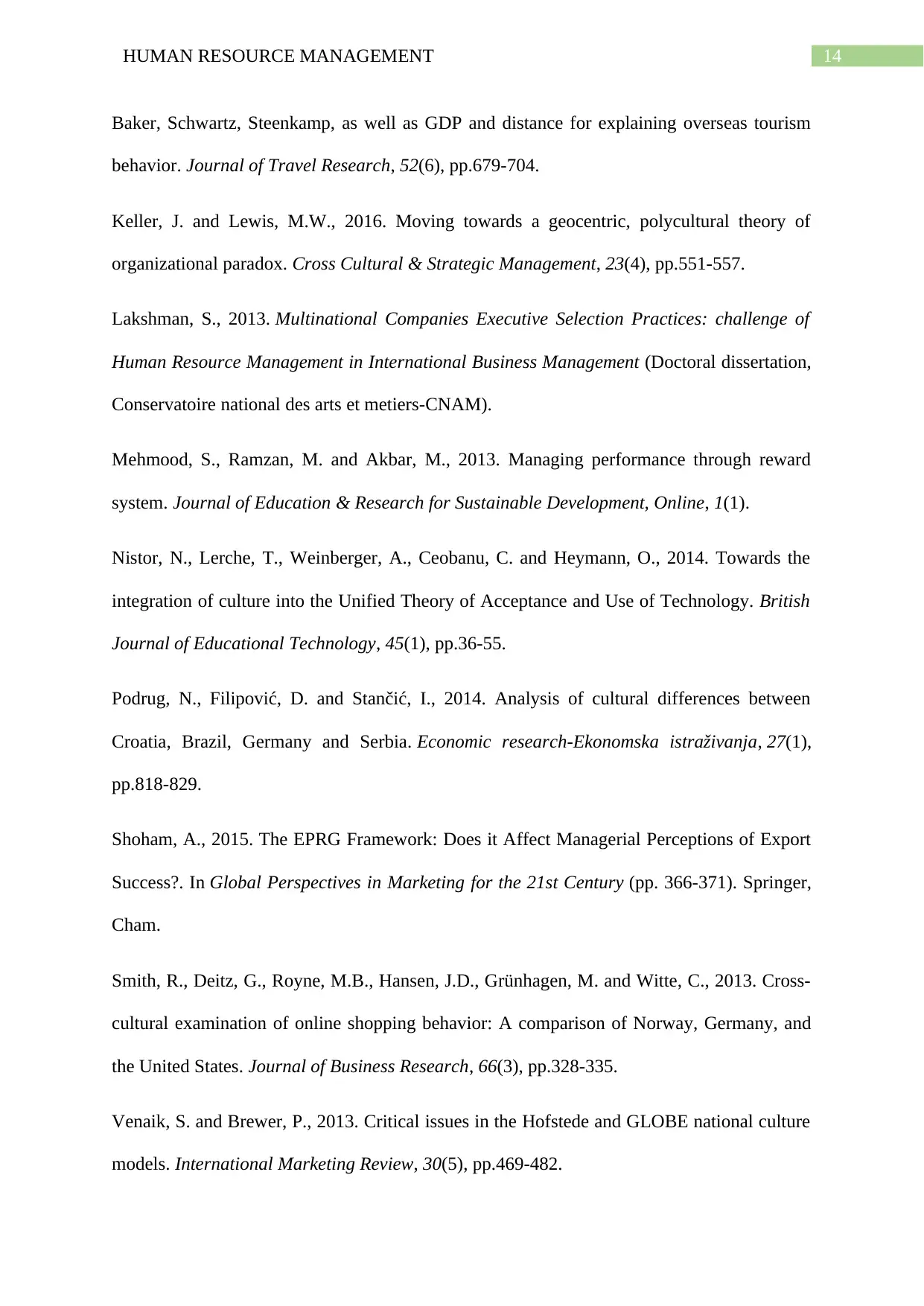
14HUMAN RESOURCE MANAGEMENT
Baker, Schwartz, Steenkamp, as well as GDP and distance for explaining overseas tourism
behavior. Journal of Travel Research, 52(6), pp.679-704.
Keller, J. and Lewis, M.W., 2016. Moving towards a geocentric, polycultural theory of
organizational paradox. Cross Cultural & Strategic Management, 23(4), pp.551-557.
Lakshman, S., 2013. Multinational Companies Executive Selection Practices: challenge of
Human Resource Management in International Business Management (Doctoral dissertation,
Conservatoire national des arts et metiers-CNAM).
Mehmood, S., Ramzan, M. and Akbar, M., 2013. Managing performance through reward
system. Journal of Education & Research for Sustainable Development, Online, 1(1).
Nistor, N., Lerche, T., Weinberger, A., Ceobanu, C. and Heymann, O., 2014. Towards the
integration of culture into the Unified Theory of Acceptance and Use of Technology. British
Journal of Educational Technology, 45(1), pp.36-55.
Podrug, N., Filipović, D. and Stančić, I., 2014. Analysis of cultural differences between
Croatia, Brazil, Germany and Serbia. Economic research-Ekonomska istraživanja, 27(1),
pp.818-829.
Shoham, A., 2015. The EPRG Framework: Does it Affect Managerial Perceptions of Export
Success?. In Global Perspectives in Marketing for the 21st Century (pp. 366-371). Springer,
Cham.
Smith, R., Deitz, G., Royne, M.B., Hansen, J.D., Grünhagen, M. and Witte, C., 2013. Cross-
cultural examination of online shopping behavior: A comparison of Norway, Germany, and
the United States. Journal of Business Research, 66(3), pp.328-335.
Venaik, S. and Brewer, P., 2013. Critical issues in the Hofstede and GLOBE national culture
models. International Marketing Review, 30(5), pp.469-482.
Baker, Schwartz, Steenkamp, as well as GDP and distance for explaining overseas tourism
behavior. Journal of Travel Research, 52(6), pp.679-704.
Keller, J. and Lewis, M.W., 2016. Moving towards a geocentric, polycultural theory of
organizational paradox. Cross Cultural & Strategic Management, 23(4), pp.551-557.
Lakshman, S., 2013. Multinational Companies Executive Selection Practices: challenge of
Human Resource Management in International Business Management (Doctoral dissertation,
Conservatoire national des arts et metiers-CNAM).
Mehmood, S., Ramzan, M. and Akbar, M., 2013. Managing performance through reward
system. Journal of Education & Research for Sustainable Development, Online, 1(1).
Nistor, N., Lerche, T., Weinberger, A., Ceobanu, C. and Heymann, O., 2014. Towards the
integration of culture into the Unified Theory of Acceptance and Use of Technology. British
Journal of Educational Technology, 45(1), pp.36-55.
Podrug, N., Filipović, D. and Stančić, I., 2014. Analysis of cultural differences between
Croatia, Brazil, Germany and Serbia. Economic research-Ekonomska istraživanja, 27(1),
pp.818-829.
Shoham, A., 2015. The EPRG Framework: Does it Affect Managerial Perceptions of Export
Success?. In Global Perspectives in Marketing for the 21st Century (pp. 366-371). Springer,
Cham.
Smith, R., Deitz, G., Royne, M.B., Hansen, J.D., Grünhagen, M. and Witte, C., 2013. Cross-
cultural examination of online shopping behavior: A comparison of Norway, Germany, and
the United States. Journal of Business Research, 66(3), pp.328-335.
Venaik, S. and Brewer, P., 2013. Critical issues in the Hofstede and GLOBE national culture
models. International Marketing Review, 30(5), pp.469-482.
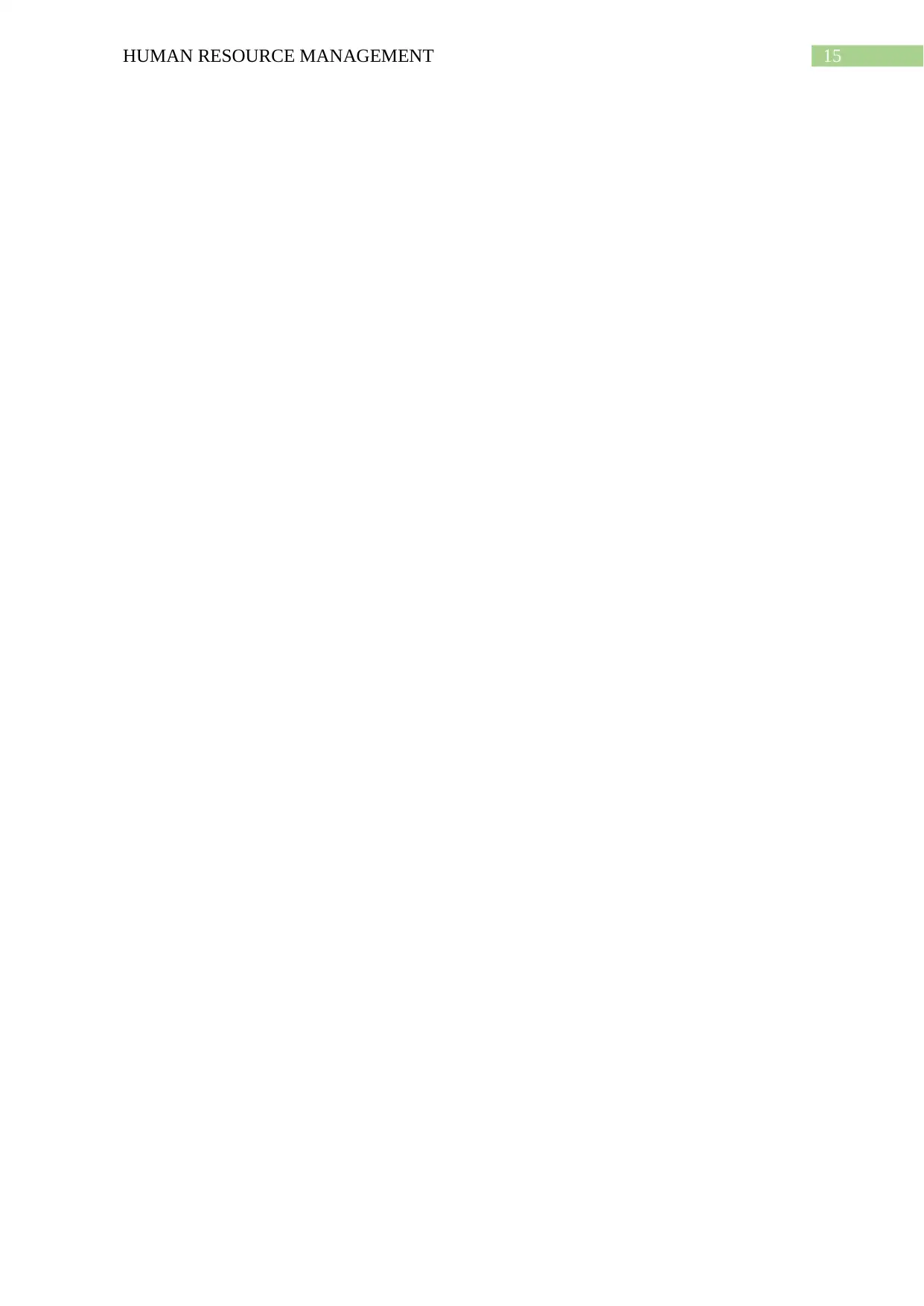
15HUMAN RESOURCE MANAGEMENT
1 out of 16
Related Documents
Your All-in-One AI-Powered Toolkit for Academic Success.
+13062052269
info@desklib.com
Available 24*7 on WhatsApp / Email
![[object Object]](/_next/static/media/star-bottom.7253800d.svg)
Unlock your academic potential
© 2024 | Zucol Services PVT LTD | All rights reserved.




